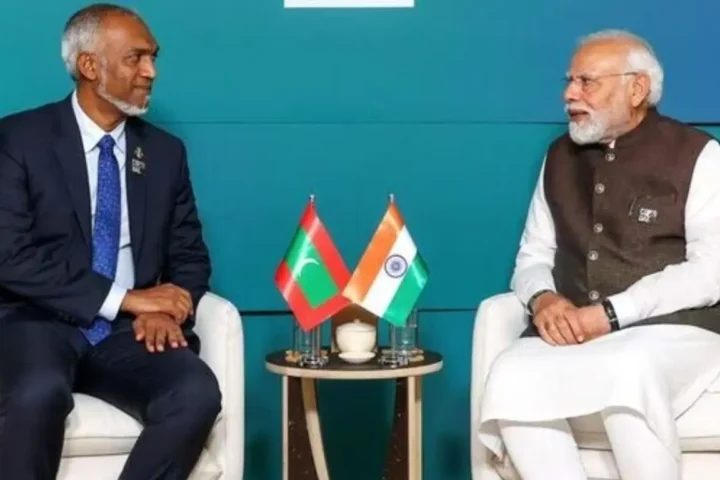
ISRO’s LVM-3 Successfully Places 36 OneWeb Satellites in Orbit, Completes Pay of INR 1000 Crore
On March 24, 2023, the Indian Space Research Organization (ISRO) successfully launched 36 OneWeb satellites into orbit using their heavy-lift launch vehicle, LVM-3. With this latest successful launch, OneWeb has completed its payment of INR 1000 crore to ISRO for launch services. This is a major milestone for OneWeb, as they are looking to challenge Starlink’s monopoly on the global satellite broadband market.
OneWeb Network Access Associates Limited is a company that was formed with the goal of creating a global satellite broadband network. The company has a stakeholder list that includes Bharti Enterprises (30%) in India, Eutelsat (22.9%) in France, the UK Government (17.6%), SoftBank (17.6%) in Japan, Hanwha (8.8%) in South Korea, Hughes Network Systems from the US, and others (3.1%). OneWeb’s main objective is to complete its constellation of 618 satellites, which will enable it to provide global satellite broadband coverage. They hope to accomplish this later this year.
OneWeb’s Relationship with India
OneWeb’s majority stake is held by Bharti Enterprises, an Indian multinational conglomerate based in New Delhi. If the majority stake had been held by Russia, OneWeb would have launched its satellites through the Russian space agency, which would have been a cheaper option. However, after the ongoing conflict between Russia and Ukraine, many countries imposed sanctions on Russia, including the UK, Japan, and South Korea. Due to these sanctions, Russia could not launch OneWeb’s satellites, and the company was left without a solution.
OneWeb eventually turned to India for help, and ISRO stepped up to provide launch services. This was a significant moment for OneWeb, as they had been struggling to find a way to launch their satellites after Russia refused to do so. The situation highlighted the importance of having multiple reliable launch options and the critical role that ISRO plays in the global space industry.
OneWeb’s Future Plans
Now that OneWeb has completed its payment to ISRO, it can focus on completing its constellation of satellites. With 36 more satellites in orbit, the company is getting closer to its goal of providing global satellite broadband coverage. OneWeb hopes to start offering its services later this year, once its constellation is fully operational.
Once OneWeb completes its constellation, it will be interesting to see how it competes with other satellite broadband providers like Starlink. OneWeb has a unique advantage in that it has a diverse stakeholder base that includes companies from different countries, which may help it navigate regulatory issues and gain access to new markets. Additionally, OneWeb has plans to offer its services in India, which could be a major market for the company given the country’s large population and growing demand for internet services.
ISRO’s LVM-3 (Launch Vehicle Mark-3) is a heavy-lift launch vehicle that was developed by the Indian Space Research Organization (ISRO). It is designed to carry large payloads into space and is one of the most powerful launch vehicles in the world.
The LVM-3 has been used for several high-profile missions, including the Chandrayaan-2 mission, which was India’s second lunar exploration mission. The LVM-3 was used to launch the spacecraft, which included an orbiter, lander, and rover.
The LVM-3 is powered by two solid rocket boosters and a cryogenic engine, which uses liquid hydrogen and liquid oxygen as fuel. This makes it more powerful than previous ISRO launch vehicles, which used only solid or liquid propellants.
One of the main advantages of the LVM-3 is its ability to carry larger payloads into space. With a capability to carry payloads up to 4 tons to Geosynchronous Transfer Orbit (GTO) and 8 tons to Low Earth Orbit (LEO), the LVM-3 has opened up new possibilities for India’s space program. It also reduces India’s reliance on foreign launch services, allowing ISRO to offer competitive pricing to its customers.
Another advantage of the LVM-3 is its modular design, which allows it to be customized for different types of missions. For example, it can be configured to carry a crew module for human spaceflight missions, or to launch interplanetary missions to Mars or beyond.
Overall, the LVM-3 represents a major step forward for India’s space program. Its capabilities have allowed India to expand its horizons and take on more ambitious missions, while reducing its dependence on foreign technology. As ISRO continues to develop new technologies and capabilities, the LVM-3 will undoubtedly play a crucial role in shaping India’s future in space.
OneWeb success in challenging Starlink’s monopoly on the global satellite broadband market will depend on several factors. One of the main advantages that OneWeb has is its ability to provide coverage in areas where traditional internet infrastructure is not available or feasible. This includes remote regions and developing countries, where there is a growing demand for high-speed internet access.
Another advantage that OneWeb has over Starlink is its focus on low latency services, which is critical for applications like online gaming and video conferencing. While Starlink has been criticized for its high latency, OneWeb is promising lower latency due to its constellation being closer to Earth than Starlink’s.
OneWeb also has plans to offer its services at a lower cost than its competitors. According to reports, OneWeb’s pricing model will be based on affordability and accessibility, which could help it gain traction in emerging markets.
The Indian Market
One of the key markets that OneWeb is targeting is India, where the company’s majority stakeholder, Bharti Enterprises, is based. India is one of the fastest-growing internet markets in the world, with a rapidly expanding middle class and increasing demand for high-speed internet access.
OneWeb’s entry into the Indian market could be a game-changer for the country’s internet landscape. The company’s satellite broadband services could provide a much-needed solution for rural areas that are currently underserved by traditional internet providers. This could help bridge the digital divide and bring economic opportunities to these regions.
In addition to providing internet access to rural areas, OneWeb’s services could also benefit urban areas in India. With increasing demand for online services like e-commerce, education, and healthcare, having reliable and affordable broadband access is becoming increasingly important.
Challenges Ahead
While OneWeb has made significant progress towards completing its constellation of satellites, the company still faces some challenges ahead. One of the main challenges is regulatory issues, as different countries have different rules and regulations when it comes to satellite broadband services.
In addition, OneWeb’s success in challenging Starlink’s dominance on the global satellite broadband market will depend on its ability to scale its operations and provide reliable and affordable services. It will also need to compete with other emerging players in the market, such as Amazon’s Project Kuiper and Telesat’s LEO constellation.
Conclusion
OneWeb is poised to become a major player in the global satellite broadband market, thanks to its diverse stakeholder base, low latency services, and focus on affordability and accessibility. The successful launch of 36 satellites by ISRO is a significant milestone for the company, as it brings it closer to completing its constellation and starting its global satellite broadband coverage later this year. As OneWeb continues to expand its services globally, it has the potential to make a significant impact on the world’s internetlandscape. Its services could help bridge the digital divide and bring economic opportunities to underserved regions. While there are challenges ahead, OneWeb’s unique advantages and commitment to providing low-cost, reliable services could help it succeed in the competitive world of satellite broadband.The successful launch of 36 OneWeb satellites by ISRO is a significant milestone for both companies. OneWeb is getting closer to completing its constellation of satellites, while ISRO has demonstrated its capabilities as a reliable launch service provider. This launch also highlights the importance of having multiple launch options and the critical role that ISRO plays in the global space industry.
As OneWeb moves forward with its plans to provide global satellite broadband coverage, it will be interesting to see how it competes with other providers in the market. With a diverse stakeholder base and plans to enter the Indian market, OneWeb has a unique advantage that could help it succeed in the competitive world of satellite broadband.









